|
|
Chapter 2: Magnetic and Electric Fields in Space
2.1 The Strength of Gravity and Electric Forces
Gravity is a relatively very weak force. The electric Coulomb force between a proton and an electron is of the order of 10^39 (that's 1 with 39 zeros after it) times stronger than the gravitational force between them.
|
|
|
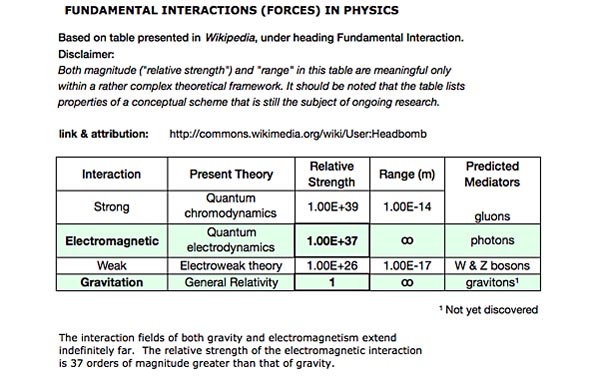
|
|
|
|
We can get a hint of the relative strength of electromagnetic forces when we use a small magnet to pick up an iron object, say a ball bearing. Even though the whole of the Earth's gravitational attraction is acting on the ball bearing, the magnet overcomes this easily when close enough to the ball bearing. In space, gravity only becomes significant in those places where the electromagnetic forces are shielded or neutralized.
|
|
|

Small magnet attracts a ball bearing against Earth's gravity's pull
|
|
|
For spherical masses and charges, both the gravity force and the electric Coulomb force vary inversely with the square of the distance and so decrease rapidly with distance. For other geometries/configurations, the forces decrease more slowly with distance. For example, the force between two relatively long and thin electric currents moving parallel to each other varies inversely with the first power of the distance between them.
Electric currents can transport energy over huge distances before using that energy to create some detectable result, just like we use energy from a distant power station to boil a kettle in our kitchen. This means that, over longer distances, electromagnetic forces and electric currents together can be much more effective than either the puny force of gravity or even the stronger electrostatic Coulomb force.
Remember that, just in order to explain the behavior of the matter we can detect, the Gravity Model needs to imagine twenty-four times more matter than we can see, in special locations, and of a special invisible type. It seems much more reasonable to investigate whether the known physics of electromagnetic forces and electric currents can bring about the observed effects instead of having to invent what may not exist.
2.2 The "Vacuum" of Space
Until about 100 years ago, space was thought to be empty. The words "vacuum" and "emptiness" were interchangeable. But probes have found that space contains atoms, dust, ions, and electrons. Although the density of matter in space is very low, it is not zero. Therefore, space is not a vacuum in the conventional sense of there being "nothing there at all". For example, the Solar "wind" is known to be a flow of charged particles coming from the Sun and sweeping round the Earth, ultimately causing visible effects like the Northern (and Southern) Lights.
The dust particles in space are thought to be 2 to 200 nanometers in size, and many of them are also electrically charged, along with the ions and electrons. This mixture of neutral and charged matter is called plasma, and it is suffused with electromagnetic fields. We will discuss plasma and its unique interactions with electromagnetic fields in more detail in Chapter 3. The "empty" spaces between
planets
or
stars
or galaxies are very different from what astronomers assumed in the earlier part of the 20th century.
(Note about terminology in links: astronomers often refer to matter in the plasma state as "gas," "winds," "hot, ionized gas," "clouds," etc. This fails to distinguish between the two differently-behaving states of matter in space, the first of which is electrically-charged plasma and the other of which may be neutral gas which is just widely-dispersed, non-ionized molecules or atoms.)
|
|
|
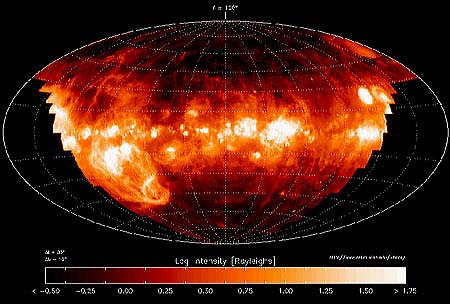
Ionized hydrogen (plasma) abundance in a northern sky survey -Wiki Commons
|
|
|
|
The existence of charged particles and electromagnetic fields in space is accepted in both the Gravity Model and the Electric Model. But the emphasis placed on them and their behavior is one distinctive difference between the models. We will therefore discuss magnetic fields next.
|
|
|

Aurora photographed by L. Zimmerman, Fairbanks AK - spaceweather.com Aurora PhotoGallery
|
|
|
2.3 Introduction to Magnetic Fields
What do we mean by the terms "magnetic field" and "magnetic field lines"? In order to understand the concept of a field, let's start with a more familiar example: gravity.
We know that gravity is a force of attraction between bodies or particles having mass. We say that the Earth's gravity is all around us here on the surface of the Earth and that the Earth's gravity extends out into space. We can express the same idea more economically by saying that the Earth has a gravitational field which extends into space in all directions. In other words, a gravitational field is a region where a gravitational force of attraction will be exerted between bodies with mass.
Similarly, a magnetic field is a region in which a magnetic force would act on a magnetized or charged body. (We will look at the origin of magnetic fields later). The effect of the magnetic force is most obvious on ferromagnetic materials. For example, iron filings placed on a surface in a magnetic field align themselves in the direction of the field like compass needles.
|
|
|
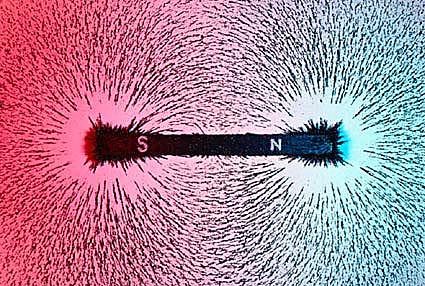
Bar magnet with iron filings showing magnetic field direction
|
|
|
Because the iron filings tend to align themselves south pole to north pole, the pattern they make could be drawn as a series of concentric lines, which would indicate the direction and strength of the field at any point.
Therefore magnetic field lines are a convenient way to represent the direction of the field, and serve as guiding centers for trajectories of charged particles moving in the field (ref. Fundamentals of Plasma Physics, Cambridge University Press, 2006, Paul Bellan, Ph.D.).
It is important to remember that field lines do not exist as physical objects. Each iron filing in a magnetic field is acting like a compass: you could move it over a bit and it would still point magnetic north-south from its new position. Similarly, a plumb bob (a string with a weight at one end) will indicate the local direction of the gravitational field. Lines drawn longitudinally through a series of plumb bobs would make a set of gravitational field lines. Such lines do not really exist; they are just a convenient, imaginary means of visualizing or depicting the direction of force applied by the field. (See Appendix I for more discussion of this subject, or
here, at Fizzics Fizzle.
A field line does not necessarily indicate the direction of the force exerted by whatever is causing the field. Field lines may be drawn to indicate direction or polarity of a force, or may be drawn as contours of equal intensities of a force, in the same way as contour lines on a map connect points of equal elevation above, say, sea level. Often, around 3-dimensional bodies with magnetic fields, imaginary surfaces are used to represent the area of equal force, instead of lines.
In a gravitational field, one could choose to draw contour lines of equal gravitational force instead of the lines of the direction of the force. These lines of equal gravitational force would vary with height (that is, with distance from the center of the body), rather like contour lines on a map. To find the direction of the force using these elevation contour lines, one would have to work out which way a body would move. Placed on the side of a hill, a stone rolls downhill, across the contours. In other words the gravitational force is perpendicular to the field lines of equal gravitational force.
Working out the direction of the force in a magnetic field is more complicated because a magnetic field has different effects on different bodies. Two permanent bar magnets with their opposite ends (opposite "poles", or N-S) facing each other will attract each other along the direction indicated by the field lines of the combined field from them both (see image above). Magnets with the same polarity (N-N or S-S) repel one another along the same direction. Ferromagnetic materials are made to act like small magnets by an external magnetic field and so will behave in the same way.
Magnetic fields also exert forces on charged particles that are in motion. Because the force that the charged particle experiences is at right angles to both the magnetic field line and the particle's direction, a charged particle moving across a magnetic field is made to change direction (i.e. to accelerate) by the action of the field. Its speed remains unchanged to conserve kinetic energy. The following image shows what happens to an electron beam in a vacuum tube before and after a magnetic field is applied, in a lab demonstration.
|
|
|

In this demonstration, a vacuum tube accelerates a narrow
beam of electrons (emitting blue light) vertically upward.
Energizing the magnetic field of the coils by passing an
electric current through them forces the electron beam to curve.
Image credit: Clemson University, Physics On-line Labs
|
|
|
The magnetic force on a charged particle in motion is analogous to the gyroscopic force. A charged particle moving directly along or "with" a magnetic field line won't experience a force trying to change its direction, just as pushing on a spinning gyroscope directly along its axis of rotation will not cause it to turn or "precess".
Even though the force on different charged particles varies, the concept of visualizing the direction of the magnetic field as a set of imaginary field lines is useful because the direction of the force on any one material, such as a moving charged particle, can be worked out from the field direction.
|
|
|
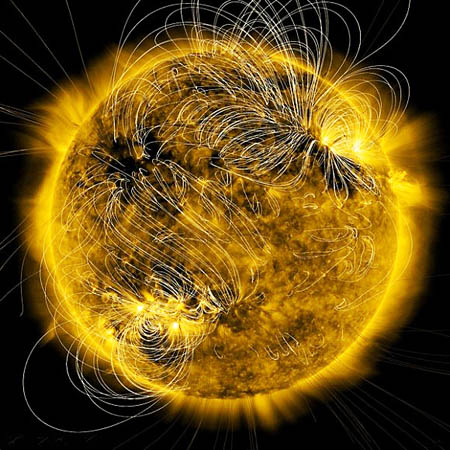
Magnetic field lines superimposed on the Sun in the
vicinity of a coronal hole and other active regions.
Understanding the dynamics of such fields helps to
understand the underlying plasma currents forming them
Image credit: NASA SDO / Lockheed Martin Space Systems Corp., 10.20.2010
|
|
|
2.4 The Origin of Magnetic Fields
Apart from by permanent magnets, magnetic fields can be generated in only two ways, both involving electricity. Permanent magnets are magnetic because the spins of the electrons orbiting their nuclei have been aligned, strengthening the overall magnetic field of the material. This alignment can be randomized if the magnet is heated to its
Curie
temperature, where the thermal motion of the atoms breaks down the orderly alignments, greatly reducing the effective strength of the magnetic field.
Static (non-changing) magnetic fields originate from permanent magnets or from constant electric currents. Time-varying magnetic fields coexist with time-varying electric currents. It is not possible to have one without the other.
More specifically, an electric current consists of moving charged particles. Every moving charged particle generates a small magnetic field around it. Wherever there are moving charge carriers there will be magnetic fields. Since electric currents can be invisible and difficult to detect at a distance, detecting a magnetic field at a location in space (by well-known methods in astronomy, see below) is a sure sign that it is being created by an electric current.
If a current flows in a conductor, such as a long straight wire or a plasma filament, then each charged particle in the current will generate a small magnetic field around it. When all the individual small magnetic fields are added together, the result is a continuous magnetic field around the whole length of the conductor. The regions in space around the wire where the field strength is equal (called "equipotential surfaces") are cylinders concentric with the wire.
|
|
|
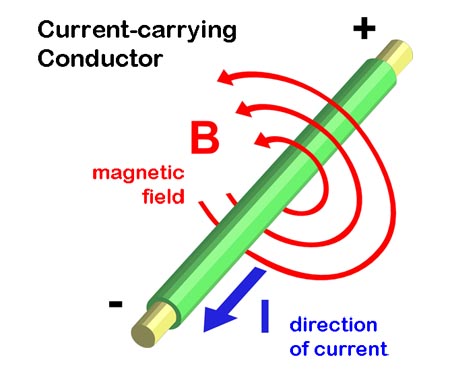
Magnetic field lines surround a conductor in concentric
equal-valued cylinders or "shells". Note that if you align
your right thumb in the direction arrow of the current,
your curled fingers show the magnetic field direction
Image credit: Wikimedia Commons, captions added
|
|
|
Time-varying electric and magnetic fields are considered later. (See Chapter IV and Appendix III)
The question of the origin of magnetic fields in space is one of the key differences between the Gravity Model and the Electric Model.
The Gravity Model allows for the existence of magnetic fields in space because they are routinely observed, but they are said to be caused by dynamos inside stars. For most researchers today, neither electric fields nor electric currents in space play any significant part in generating magnetic fields in the Gravity Model.
In contrast, the Electric Model, as we shall see in more detail later, argues that magnetic fields must be generated by the movement of charged particles in space in the same way that magnetic fields are generated by moving charged particles here on Earth. Of course, the Electric Model accepts that stars and planets have magnetic fields, too, evidenced by magnetospheres and other observations. The new insight has been to explain a different origin for these fields in space if they are not created by dynamos in stars.
2.5 Detecting Magnetic Fields in Space
Since the start of the space age, spacecraft have been able to measure magnetic fields in the solar system using instruments on board the spacecraft. We can "see" magnetic fields beyond the range of spacecraft because of the effect that the fields have on light and other radiation passing through them. We can even estimate the strength of the magnetic fields by measuring the amount of that effect.
|
|
Optical Image Magnetic field intensities, directions
|
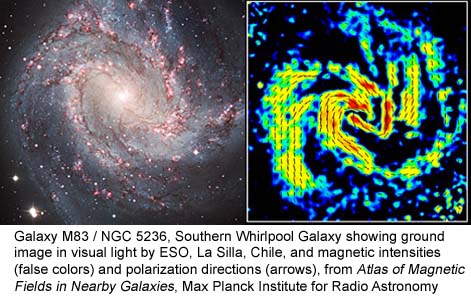
Courtesy Rainer Beck and Bill Sherwood (ret.), Max-Planck Insitut für Radio-Astronomie
|
|
|
We have known about the Earth's magnetic field for centuries. We can now detect such fields in space, so the concept of magnetic fields in space is intuitively easy to understand, although astronomers have difficulty in explaining the origination of these magnetic fields.
Magnetic fields can be detected at many wavelengths by observing the amount of symmetrical spectrographic emission or absorption line splitting (the Zeeman effect, after Dutch physicist and 1902 Nobel laureate, Pieter Zeeman, 1865–1943) induced by the presence of magnetic fields.
|
|
|
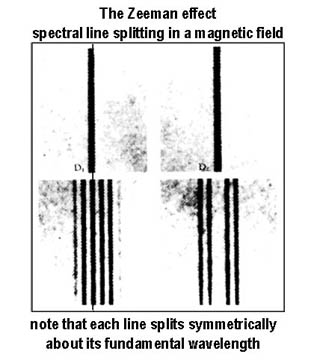
A spectrogram of light passing through a magnetic field
exhibits symmetrical line broadening or splitting about
the original wavelength of the bright or dark line
image credit: www.chemteam.info/classical papers/no. 38,
"1897 - the Zeeman effect". [Photo originally made by P. Zeeman]
|
|
|
Another indicator of the presence of magnetic fields is the polarization of synchrotron emission radiated by electrons in magnetic fields, useful at galactic scales. See Beck's
article on Galactic Magnetic Fields in Scholarpedia
and Beck & Sherwood's
Atlas of Magnetic Fields in Nearby Galaxies
Magnetic fields are included in both the Gravity Model and the Electric Model of the Universe. The essential difference is that the Electric Model recognizes that magnetic fields in space are caused or generated by electric currents. We will take up electric fields and currents next.
2.6 Introduction to Electric Fields
An electric charge has polarity. That is, it is either positive or negative. By agreement, the elementary (smallest) unit of charge is equal to that of an electron (-e) or a proton (+e). Electric charge is quantized; it is always an integer multiple of e.
The fundamental unit of charge is the coulomb (C), where e = 1.60 x10^-19 coulomb. By taking the inverse of the latter tiny value, one coulomb is 6.25x10^18 charged particles. One ampere (A) of electric current is one coulomb per second. A 20A current thus would be 20 C of charge per second, or the passage of 1.25x 10^20 electrons per second past a fixed point.
Every charge has an electric field associated with it. An electric field is similar to a magnetic field in that it is caused by the fundamental force of electromagnetic interaction and its "range" or extent of influence is infinite, or indefinitely large. The electric field surrounding a single charged particle is spherical, like the gravitational acceleration field around a small point mass or a large spherical mass.
|
|
|
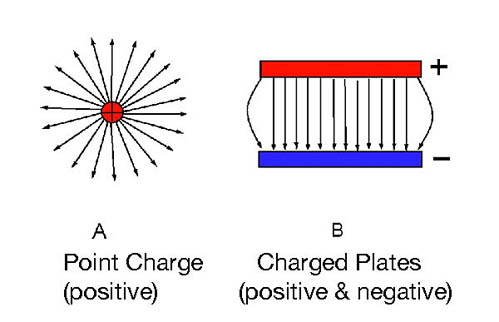
Electric field around a single positive charge and between two charged plates.
Arrows indicate the direction of the force on a positive charge; force would
be applied in the opposite direction on a negative charge
|
|
|
The strength of an electric field at a point is defined as the force in newtons (N) that would be exerted on a positive test charge of 1 coulomb placed at that point. Like gravity, the force from one charge is inversely proportional to the square of the distance to the test (or any other) charge.
The point in defining a test charge as positive is to consistently define the direction of the force due to one charge acting upon another charge. Since like charges repel and opposites attract, just like magnetic poles, the imaginary electric field lines tend to point away from positive charges and toward negative charges. See a short video on the electric field
here.
Here is a user-controlled demonstration of 2 charges and their associated lines of force in this
Mathematica application. You may need to download Mathematica Player (just once, and it's free) from the linked web site to play with the demo. Click on "Download Live Demo"after you install Mathematica Player. You can adjust quantity and type of charge (+ or -) with the sliders, and drag the charged particles around the screen.
Electromagnetic forces are commonly stronger than gravitational forces on plasma in space. Electromagnetism can be shielded, while gravity can not, so far as is known. The common argument in the standard model is that most of the electrons in one region or body are paired with protons in the nuclei of atoms and molecules, so the net forces of the positive charges and negative charges cancel out so perfectly that "for large bodies gravity can dominate" (reference: Wikipedia on Fundamental Interactions, under Electromagnetism sub-heading).
What is overlooked above is that, with the rare exception of relatively cool, stable and net-neutral environments like those found here on Earth, everything else in the Universe consists of plasma; i.e., charged particles and neutral particles moving in a complex symphony of charge separation and the electric and magnetic fields of their own making, wherein gravity, while present, is not typically the dominant force.
Far from consisting of mostly neutralized charge and weak magnetic and electric fields and their associated weak currents, electric fields and currents in plasma can and often do become very large and powerful in space. The Electric Model holds that phenomena in space such as magnetospheres, Birkeland currents, stars, pulsars, galaxies,galactic and stellar jets, planetary nebulas, "black holes", energetic particles such as gamma rays and X-rays and more are fundamentally electric events in plasma physics. Even the rocky bodies — planets, asteroids, moons and comets, and the gas bodies in a solar system — exist in the heliospheres of their stars, and are not exempt from electromagnetic forces and their effects.
Each separate charged particle contributes to the total electric field. The net force at any point in a complex electromagnetic field can be calculated using vectors, if the charges are assumed stationary. If charged particles are moving (and they always are), however, they create magnetic fields, too, and this changes the magnetic configuration. Changes in a magnetic field in turn create electric fields and thereby affect currents themselves, so fields that start with moving particles represent very complex interactions and messy mathematics.
Charges in space may be distributed spatially in any configuration. If, instead of a point or a sphere, the charges are distributed in a linear fashion so that the length of a charged area is much longer than its width or diameter, it can be shown that the electric field surrounds the linear shape like cylinders of equal force potential, and that the field from this configuration decreases with distance from the configuration as the inverse of the distance (not the inverse square of the distance) from the centerline. This is important in studying the effects of electric and magnetic fields in filamentary currents such as lightning strokes, a plasma focus, or large Birkeland currents in space.
Remember that the direction of applied force on a positive charge starts from positive charge and terminates on negative charge, or failing a negative charge, extends indefinitely far. Even a small charge imbalance with, say, more positively-charged particles here and more negatively-charged particles a distance away leads to a region of force or electric field between the areas of separated dissimilar charges.
Think of an electrical capacitor where there are two separated, oppositely charged plates or layers, similar to the two charged plates "B" in the diagram above. There will be an electric field between the layers. Any charged particle moving or placed between the layers will be accelerated towards the oppositely charged layer. Electrons (which are negatively charged) accelerate toward the positively charged layer, and positive ions and protons toward the negatively charged layer.
|
|
|

A candle flame in an electric field between two charged plates
will be oriented sideways because a flame is a partially ionized plasma
and therefore responds strongly to the electric force rather than
the thermal convective forces in a gravity field
|
|
|
According to Newton's Laws, force results in acceleration. Therefore electric fields will result in charged particles' acquiring velocity. Oppositely charged particles will move in opposite directions. An electric current is, by definition, movement of charge past a point. Electric fields therefore cause electric currents by giving charged particles a velocity.
If an electric field is strong enough, then charged particles will be accelerated to very high velocities by the field. For a little further reading on electric fields see
electric fields, by Fizzics Fizzle.
2.7 Detecting Electric Fields and Currents in Space
Electric fields and currents are more difficult to detect without putting a measuring instrument directly into the field, but we have detected currents in the solar system using spacecraft. One of the first was the low-altitude polar orbit TRIAD satellite in the 1970s, which found currents interacting with the Earth's upper atmosphere. In 1981 Hannes Alfvén decribed a heliospheric current model in his book, Cosmic Plasma.
Since then, a region of electric current called the heliospheric current sheet (HCS) has been found that separates the positive and negative regions of the Sun's magnetic field. It is tilted approximately 15 degrees to the solar equator. During one half of a solar cycle, outward-pointing magnetic fields lie above the HCS and inward-pointing fields below it. This is reversed when the Sun's magnetic field reverses its polarity halfway through the solar cycle. As the Sun rotates, the HCS rotates with it, "dragging" its undulations into what NASA terms "the standard Parker spiral".
Some links to heliospheric current sheet sites are
Wikipedia,
NASA,
Mathematica demonstration, and
Belgian Institute of Aeronomy.
|
|
|
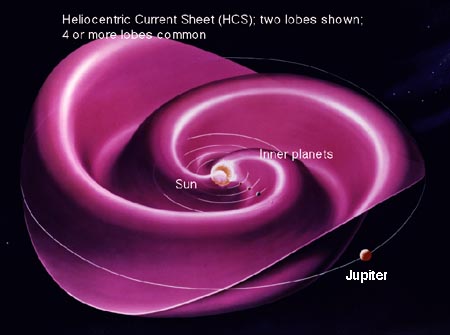
Depiction of the Heliocentric Current Sheet (HCS)
around the Sun, with typical ripples dragged into
a spiral configuration
Credit: Wiki Commons
|
|
|
|
Spacecraft have measured changes over time in the current sheet at various locations since the 1980s. They have detected near-Earth and solar currents as well. The Gravity Model accepts that these currents exist in space but assumes they are a result of the magnetic field. We will return to this point later.
|
|
|
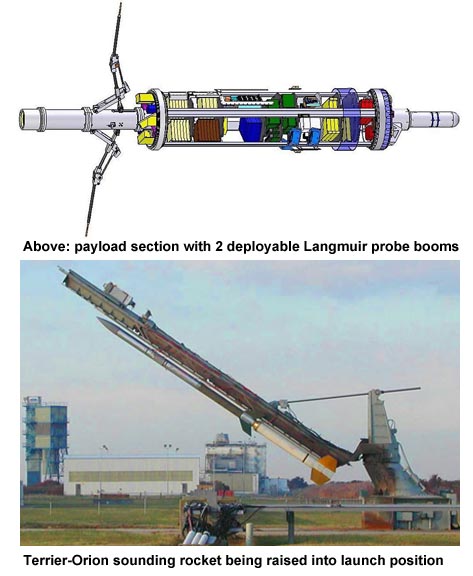
Research rocket with SPIRIT II payload containing
extendable payload booms with Langmuir probes to detect
electric fields and ions in near-Earth plasma, courtesy
NASA Wallops Flight Facility and Penn State University
|
|
|
|
Electric fields outside the reach of spacecraft are not detectable in precisely the same way as magnetic fields. Line-splitting or broadening in electric fields occurs, but it is asymmetrical line splitting that indicates the presence of an electric field, in contrast to the symmetric line splitting in magnetic fields. Further, electric field line broadening is sensitive to the mass of the elements emitting light (the lighter elements being readily broadened or split, and heavier elements less so affected), while Zeeman (magnetic field) broadening is indifferent to mass. Asymmetric bright-line splitting or broadening is called the Stark effect, after Johannes Stark, 1874–1957
|
|
|
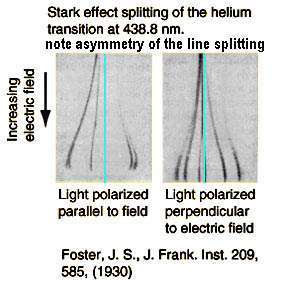
Spectrographic line broadening of helium increases with
the strength of the electric field through which it passes.
Heavier elements exhibit less line splitting than lighter ones
Image credit: Journal of the Franklin Institute, 1930
|
|
|
Another way in which we can detect electric fields is by inference from the behavior of charged particles, especially those that are accelerated to high velocities, and the existence of electromagnetic radiation such as X-rays in space, which we have long known from Earth-bound experience are generated by strong electric fields.
Electric currents in low density plasmas in space operate like fluorescent lights or evacuated Crookes Tubes. In a weak current state, the plasma is dark and radiates little visible light (although cold, thin plasma can radiate a lot in the radio and far infrared wavelengths). As current increases, plasma enters a glow mode, radiating a modest amount of electromagnetic energy in the visible spectrum. This is visible in the image at the end of this chapter. When electrical current becomes very intense in a plasma, the plasma radiates in the arc mode. Other than scale, there is little significant difference between lightning and the radiating surface of a star's photosphere.
This means, of course, that alternative explanations for these effects are also possible, at least in theory. The Gravity Model often assumes that the weak force of gravity multiplied by supernatural densities that are hypothesized to make up black holes or neutron stars creates these types of effect. Or maybe particles are accelerated to near-light-speed by supernovae explosions. The question is whether "multiplied gravity" or lab-testable electromagnetism is more consistent with observations that the Universe is composed of plasma.
The Electric Model argues that electrical effects are not just limited to those parts of the solar system that spacecraft have been able to reach. The Electric Model supposes that similar electrical effects also occur outside the solar system. After all, it would be odd if the solar system was the only place in the Universe where electrical effects do occur in space.
2.8 The Extent of Electromagnetic Fields in Space
In the Gravity Model, only static magnetic fields are thought to have any effect in space. The Gravity Model adopts the simplifying assumption that electricity plays no significant part in the dynamics of the Universe and that magnetic fields are 'frozen in' to the plasma - an idea repudiated by the Nobel prize winner, Hannes Alfvén, who first proposed it. In the Gravity Model, the force of gravity rules the behavior of the cosmos.
By contrast, in the Electric model, the magnetic fields in space derive from electric currents. In the Electric Model, the complex interactions among electric currents, magnetic fields, electric fields, and charge separation deeply influence the behavior of matter and energetic events throughout the Universe.
|
|
|

The Veil Nebula, NGC 6960, gauzy, glowing filamentary plasma
currents and current sheets spanning the light years
click to enlarge
Image credit: T.A. Rector, University of Alaska Anchorage
Kitt Peak WIYN 0.9m telescope/NOAO/AURA/NSF
|
|
|
|
|
end of Chapter 2
|
previous: Chapter 1: Distances in Space
next: Chapter 3: Plasma
|
|
|
Permalink to this page
Return to Preface
|
|
|
|
|
|
|



















